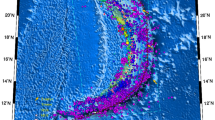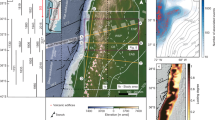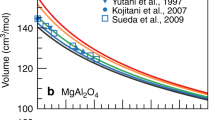Abstract
Within oceanic lithosphere a fossilized fabric is often preserved originating from the time of plate formation. Such fabric is thought to form at the mid-ocean ridge when olivine crystals align with the direction of plate spreading1,2. It is unclear, however, whether this fossil fabric is preserved within slabs during subduction or overprinted by subduction-induced deformation. The alignment of olivine crystals, such as within fossil fabrics, can generate anisotropy that is sensed by passing seismic waves. Seismic anisotropy is therefore a useful tool for investigating the dynamics of subduction zones, but it has so far proved difficult to observe the anisotropic properties of the subducted slab itself. Here we analyse seismic anisotropy in the subducted Nazca slab beneath Peru and find that the fast direction of seismic wave propagation aligns with the contours of the slab. We use numerical modelling to simulate the olivine fabric created at the mid-ocean ridge, but find it is inconsistent with our observations of seismic anisotropy in the subducted Nazca slab. Instead we find that an orientation of the olivine crystal fast axes aligned parallel to the strike of the slab provides the best fit, consistent with along-strike extension induced by flattening of the slab during subduction (A. Kumar et al., manuscript in preparation). We conclude that the fossil fabric has been overprinted during subduction and that the Nazca slab must therefore be sufficiently weak to undergo internal deformation.
This is a preview of subscription content, access via your institution
Access options
Subscribe to this journal
Receive 12 print issues and online access
$259.00 per year
only $21.58 per issue
Buy this article
- Purchase on Springer Link
- Instant access to full article PDF
Prices may be subject to local taxes which are calculated during checkout



Similar content being viewed by others
References
Francis, T. Generation of seismic anisotropy in the upper mantle along the mid-oceanic ridges. Nature 221, 162–165 (1969).
Hess, H. Seismic anisotropy of the uppermost mantle under oceans. Nature 203, 629–631 (1964).
Zhang, S. & Karato, S. Lattice preferred orientation of olivine aggregates deformed in simple shear. Nature 375, 774–777 (1995).
Karato, S. Deformation of Earth Materials. An Introduction to the Rheology of Solid Earth (Cambridge Univ. Press, 2008).
Maggi, A., Debayle, E., Priestley, K. & Barruol, G. Azimuthal anisotropy of the Pacific region. Earth Planet. Sci. Lett. 250, 53–71 (2006).
Debayle, E. & Ricard, Y. Seismic observations of large-scale deformation at the bottom of fast-moving plates. Earth Planet. Sci. Lett. 376, 165–177 (2013).
Beghein, C., Yuan, K., Schmerr, N. & Xing, Z. Changes in seismic anisotropy shed light on the nature of the Gutenberg discontinuity. Science 343, 1237–1240 (2014).
Wolfe, C. & Silver, P. Seismic anisotropy of oceanic upper mantle: Shear wave splitting methodologies and observations. J. Geophys. Res. 103, 749–771 (1998).
Harmon, N., Forsyth, D. W., Fischer, K. M. & Webb, S. C. Variations in shear-wave splitting in young Pacific seafloor. Geophys. Res. Lett. 31, L15609 (2004).
Gaherty, J. B., Lizarralde, D., Collins, J. A., Hirth, G. & Kim, S. Mantle deformation during slow seafloor spreading constrained by observations of seismic anisotropy in the western Atlantic. Earth Planet. Sci. Lett. 228, 255–265 (2004).
Audet, P. Seismic anisotropy of subducting oceanic uppermost mantle from fossil spreading. Geophys. Res. Lett. 40, 173–177 (2013).
Song, T.-R. A. & Kim, Y. Anisotropic uppermost mantle in young subducted slab underplating Central Mexico. Nature Geosci. 5, 55–59 (2012).
Faccenda, M., Burlini, L., Gerya, T. V. & Mainprice, D. Fault-induced seismic anisotropy by hydration in subducting oceanic plates. Nature 455, 1097–1100 (2008).
Eberhart-Phillips, D. & Reyners, M. Three-dimensional distribution of seismic anisotropy in the Hikurangi subduction zone beneath the central North Island, New Zealand. J. Geophys. Res. 114, B06301 (2009).
Wagner, L., Fouch, M., James, D. & Long, M. The role of hydrous phases in the formation of trench parallel anisotropy: Evidence from Rayleigh waves in Cascadia. Geophys. Res. Lett. 40, 1–5 (2013).
Yu, D. & Wang, L. P-wave anisotropy tomography of central Japan: Insight into subduction dynamics. Tectonophysics 592, 14–30 (2013).
Eakin, C. M. & Long, M. D. Complex anisotropy beneath the Peruvian flat slab from frequency-dependent, multiple-phase shear wave splitting analysis. J. Geophys. Res. 118, 4794–4813 (2013).
Russo, R. & Silver, P. Trench-parallel flow beneath the Nazca plate from seismic anisotropy. Science 263, 1105–1111 (1994).
Eakin, C. M., Long, M. D., Wagner, L. S., Beck, S. L. & Tavera, H. Upper mantle anisotropy beneath Peru from SKS splitting: Constraints on flat slab dynamics and interaction with the Nazca Ridge. Earth Planet. Sci. Lett. 412, 152–162 (2015).
Matchem, I., Savage, M. K. & Gledhill, K. R. Distribution of seismic anisotropy in the subduction zone beneath the Wellington region, New Zealand. Geophys. J. Int. 140, 1–10 (2000).
Hiramatsu, Y., Ando, M. & Ishikawa, Y. ScS wave splitting of deep earthquakes around Japan. Geophys. J. Int. 128, 409–424 (1997).
Faccenda, M. Water in the slab: A trilogy. Tectonophysics 614, 1–30 (2014).
Turcotte, D. L. & Schubert, G. Geodynamics (Cambridge Univ. Press, 2002).
Hager, B. Subducted slabs and the geoid: Constraints on mantle rheology and flow. J. Geophys. Res. 89, 6003–6015 (1984).
Farrington, R. J., Moresi, L.-N. & Capitanio, F. A. The role of viscoelasticity in subducting plates. Geochem. Geophys. Geosyst. 15, 4291–4304 (2014).
Fourel, L., Goes, S. & Morra, G. The role of elasticity in slab bending. Geochem. Geophys. Geosyst. 15, 4507–4525 (2014).
Gripp, A. E. & Gordon, R. G. Young tracks of hotspots and current plate velocities. Geophys. J. Int. 150, 321–361 (2002).
Müller, R., Sdrolias, M., Gaina, C. & Roest, W. Age, spreading rates, and spreading asymmetry of the world’s ocean crust. Geochem. Geophys. Geosyst. 9, 18–36 (2008).
Ekström, G., Nettles, M. & Dziewoński, A. M. The Global CMT project 2004–2010: Centroid-moment tensors for 13,017 earthquakes. Phys. Earth Planet. Inter. 200–201, 1–9 (2012).
Eakin, C. M. et al. Response of the mantle to flat slab evolution: Insights from local S splitting beneath Peru. Geophys. Res. Lett. 41, 3438–3446 (2014).
Wüstefeld, A., Bokelmann, G., Zaroli, C. & Barruol, G. SplitLab: A shear-wave splitting environment in Matlab. Comput. Geosci. 34, 515–528 (2008).
Lynner, C. & Long, M. D. Sub-slab seismic anisotropy and mantle flow beneath the Caribbean and Scotia subduction zones: Effects of slab morphology and kinematics. Earth Planet. Sci. Lett. 361, 367–378 (2013).
Walker, A. M. & Wookey, J. MSAT—A new toolkit for the analysis of elastic and seismic anisotropy. Comput. Geosci. 49, 81–90 (2012).
Bunge, H. J. in Preferred Orientation in Deformed Metal and Rocks: An Introduction to Modern Texture Analysis (ed. Wenk, H. R.) 73–108 (Academic, 1985).
Acknowledgements
The PULSE deployment was facilitated by the PASSCAL program of IRIS (Incorporated Research Institutions for Seismology) and the data was accessed through the IRIS Data Management Center (DMC). We thank all those from Yale University, University of North Carolina—Chapel Hill, University of Arizona and the Instituto Geofísico del Perú (IGP) who participated in the fieldwork. We thank R. Clayton and P. Davis for providing access to data from PeruSE stations. We acknowledge helpful discussions and suggestions by S. Karato on modelling anisotropy within the slab. The PULSE experiment was supported by National Science Foundation grants EAR-0943962 (M.D.L.), EAR-0944184 (L.S.W.), and EAR-0943991 (S.L.B.).
Author information
Authors and Affiliations
Contributions
C.M.E. conceived the paper topic, made the measurements, and carried out the modelling in collaboration with M.D.L.; A.S. and G.Z. provided the tomographic images and slab contours; M.D.L., S.L.B., L.S.W. and H.T. were principal investigators on the PULSE deployment; C.M.E. and M.D.L. co-wrote the paper with feedback and input from all co-authors.
Corresponding author
Ethics declarations
Competing interests
The authors declare no competing financial interests.
Supplementary information
Supplementary Information
Supplementary Information (PDF 3792 kb)
Supplementary Information
Supplementary Information (XLSX 49 kb)
Supplementary Movies
Supplementary Movie 1 (MOV 76615 kb)
Supplementary Movies
Supplementary Movie 2 (MOV 71878 kb)
Rights and permissions
About this article
Cite this article
Eakin, C., Long, M., Scire, A. et al. Internal deformation of the subducted Nazca slab inferred from seismic anisotropy. Nature Geosci 9, 56–59 (2016). https://doi.org/10.1038/ngeo2592
Received:
Accepted:
Published:
Issue Date:
DOI: https://doi.org/10.1038/ngeo2592
This article is cited by
-
Large-scale variation in seismic anisotropy in the crust and upper mantle beneath Anatolia, Turkey
Communications Earth & Environment (2021)



